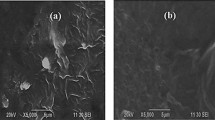Abstract
Thin films of sodium alginate (SA) were prepared by casting from methanol solutions. Tensile strength and elongation at break (Eb%) of the films were found to be 20.4 MPa and 11.6 %, respectively. A series of SA solutions (formulations) were prepared by blending varying percentages (2–8 % by wt) of ethylene glycol (EG) and then films were prepared and cured under UV radiation at different intensities (5–35 UV passes). Monomer concentration, soaking time, and radiation dose were optimized in terms of polymer loading and mechanical properties of the cured films. For the improvement of the properties, several acrylic monomers of different functionalities as additives (2 %) like 2-ethylhexyl acrylate, 1,4-butanediol diacrylate, and trimethylolpropane triacrylate were incorporated with EG with the aid of UV radiation. Further analyses of the prepared films were characterized by FTIR and thermogravimetric analysis. Water uptake behavior was determined for the raw and cured SA films.






Similar content being viewed by others
References
Stanford ECC (1881) Improvements in the manufacture of useful products from seaweeds, British Patent 142
Fan L, Du Y, Huang R, Wang Q, Zhang L (2005) Preparation and characterization of alginate/gelatin blend fibers. J Appl Polym Sci 96:1625–1629
Qin Y (2004) Gel swelling properties of alginate fibers. J Appl Polym Sci 91:1641–1645
Lee YJ, Shin DS, Kwon OW, Park WH, Choi HG, Lee YR, Han SS, Noh SK, Lyoo WS (2007) Preparation of atactic poly(vinyl alcohol)/sodium alginate blend nanowebs by electrospinning. J Appl Polym Sci 106:1337–1342
Rhim JW, Kim JH, Kim DH (2003) Modification of Na-alginate films by CaCl2 treatment. Korean J Food Sci Technol 35:217–221
Rhim JW, Kim JH (2004) Preparation of bio-degradable films using various marine algae powder. Korean J Food Sci Technol 36:69–74
Rhim JW (2004) Physical and mechanical properties of water resistant sodium alginate films. Lebensm-Wiss Technol 37:323–330
Roger S, Talbot D, Bee A (2006) Preparation and effect of Ca2+ on water solubility, particle release and swelling properties of magnetic alginate films. J Magn Magn Mater 305:221–227
Moe ST, Draget KI, Skjåk-Bræk G, Smidsrød O (1995) Alginates. In: Stephen AM (ed) Food polysaccharides and their applications. Marcel Dekker Inc., New York, pp 245–286
Kwok KK, Groves MJ, Burgess DJ (1991) Production of 5–15 microns diameter alginate-polylysine microcapsules by an air-atomization technique. Pharm Res 8:341–344
Sugwara S, Imai T, Otagiri M (1994) The controlled release of prednisolone using alginate gelatin. Pharm Res 11:272–277
Yuk SH, Cho SH, Lee HB (1995) pH-sensitive drug delivery system using O/W emulsion. J Controlled Release 7:69–74
Hari PR, Chandy T, Sharma CP (1996) Chitosan/calcium-alginate beads for oral delivery of insulin. J Appl Polym Sci 59:1795–1801
Mutalik V, Manjeshwar LS, Wali A, Sairam M, Raju KVSN, Aminabhavi TM (2006) Thermodynamics/hydrodynamics of aqueous polymer solutions and dynamic mechanical characterization of solid films of chitosan, sodium alginate, guar gum, hydroxyl ethyl cellulose and hydroxypropyl methylcellulose at different temperatures. Carbohydr Polym 65:9–21
Gennadios A, Park HJ, Weller CL (1993) Relative humidity and temperature effects on tensile strength of edible protein and cellulose ether films. Trans ASAE 37:1867–1872
Gontard N, Guilbert S, Cuq J (1993) Water and glycerol as plasticizer affect mechanical and water vapor barrier properties of an edible wheat gluten film. J Food Sci 58:206–211
Rhim JW, Kim JH (2004) Increase in moisture barrier properties of alginate-based films by compositing with fatty acids and CaCl2 treatment. Korean J Food Sci Technol 36:432–439
Yinghai L, Lanying Y, Junbo L, Zengqian S (2005) Grafting of methylmethacrylate onto sodium alginate initiated by potassium ditelluratoargentate (III). J Appl Polym Sci 97:1688–1694
Mc Gininse VD (1986) Encyclopedia of polymer science and technology. Wiley, New York, p 418
Jean-Pierre F (1995) Photoinitiator, photopolymerization and photocuring fundamentals application. Hanser/Gardner Publications, Inc., Cincinnati, pp 388–392
Rahman MM, Khan MA, Ali KMI, Mustafa AI (2001) Effect of CaCO3 on the performance of Partex surface modification by ultraviolet radiation curing method. J Appl Polym Sci 81(8):1858–1867
Khan MA, Ali KMI (1997) Radiation induced jute plastic composites: preparation and its IR studies. Polym Plast Technol Eng 36(1):89–104
Viengkhon V, Ng L, Garnett JL (1997) The effect of additives on the enhancement of methyl methacrylate grafting to cellulose in the presence of UV and ionising radiation. Radiat Phys Chem 49(5):595–602
Author information
Authors and Affiliations
Corresponding author
Rights and permissions
About this article
Cite this article
Zaman, H.U., Khan, M.A. & Khan, R.A. Modification and characterization of photo-cured sodium alginate film with ethylene glycol: effect of additives. Polym. Bull. 70, 181–194 (2013). https://doi.org/10.1007/s00289-012-0796-9
Received:
Revised:
Accepted:
Published:
Issue Date:
DOI: https://doi.org/10.1007/s00289-012-0796-9




